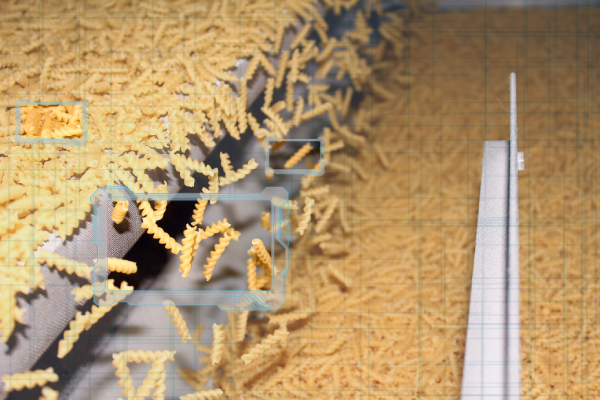AI-driven Quality Control
Optimizing efficiency and quality control in the food industry
Challenge
 In the food industry, and especially for a nationally important product sector as pasta production, key challenges arise to process anomalies in drying, storage, and packaging stages, which are crucial for maintaining the highest quality standards.
In the food industry, and especially for a nationally important product sector as pasta production, key challenges arise to process anomalies in drying, storage, and packaging stages, which are crucial for maintaining the highest quality standards.
During the delicate drying process, an occasional mishap can result in some pasta pieces getting stuck in the line, causing over-drying and ultimately affecting the pasta's desired texture and taste. This issue not only impacts the product quality but also increases waste and production costs.
In addition to the drying phase, mishandling of storage silos poses another obstacle. Mixing different pasta formats within these storage silos can lead to confusion and inconsistency in the final product.
Maintaining the integrity of each pasta variety is paramount for a premium and diverse product line. Furthermore, ensuring uniformity in appearance is a constant battle. Abnormalities in color and size occasionally find their way into the packaging line, creating discrepancies that can negatively influence consumer perceptions and brand reputation.
RINA solution
Leveraging RINA knowledge about processes optimization and expertise in data analysis and image processing techniques, an automated highly sensitive inspection system has been developed, which integrates hardware solutions to obtain reliable images of the pasta, along with AI software solutions that guarantee consistent detection of color and shape defects in the pasta pieces.
The system employs an internal conveyor belt to stabilize imaging conditions, including background color, and carefully designed lighting to capture images with stable colors, facilitating later identification of color defects. RINA engineers achieved the goal to create an integrated system able to detect color and shape defects accurately just before packaging, allowing automatic rejection of defective materials and therefore contributing to ensure the production of high-quality pasta and at the same time reducing waste.
The AI-driven software plays a crucial role in the solution. It utilizes image processing techniques for pasta color analysis, enabling the detection and rejection of pasta pieces that deviate from the desired standard while intelligently recognizing and retaining slow color variations typical in this type of production, which do not constitute defects. Moreover, the AI technology is fundamental in detecting shape defects. As pasta pieces arrive randomly and may take on various orientations in the images, finding robust algorithms to separate pieces with different shapes can be challenging. The AI software addresses this complexity, ensuring accurate identification of shape defects even when correctly shaped pasta pieces may appear different due to variations.
Benefit for the stakeholders
The developed solution, integrating advanced hardware engineering and AI-driven software, offers significant benefits to stakeholders in the food production industry, strengthening their competitive positioning in the industry, and potentially leading to increased market share and customer satisfaction.
- High-Quality Food Production: By integrating advanced hardware engineering and AI-driven software, the solution ensures the consistent production of high-quality food products.
- Defect Detection and Rejection: The AI-powered inspection system accurately detects color and shape defects in food items just before packaging, enabling automatic rejection of defective materials. This minimizes the chances of subpar products reaching consumers.
- Waste Reduction: Prompt detection of defects allows for immediate corrective actions, reducing waste during production. This enhances overall process efficiency and resource utilization.
- Process Enhancement: The solution's robust hardware and software combination enhances the entire food production process, guaranteeing reliable and uniform quality.
- Immediate Corrective Actions: The system alerts manufacturers to the presence and type of defects, enabling swift corrective measures and preventing further production of flawed items.
- Flexible Integration: The inspection system can be easily integrated into existing production lines without requiring significant plant alterations, making it a cost-effective solution for food producers.
The flexibility of the solution makes it applicable to different production-centered industries. For instance, it can be adapted for quality control in the confectionery sector, pharmaceutical manufacturing, or automotive parts production, providing robust inspection and improving product quality.
Explore our related services
- Food